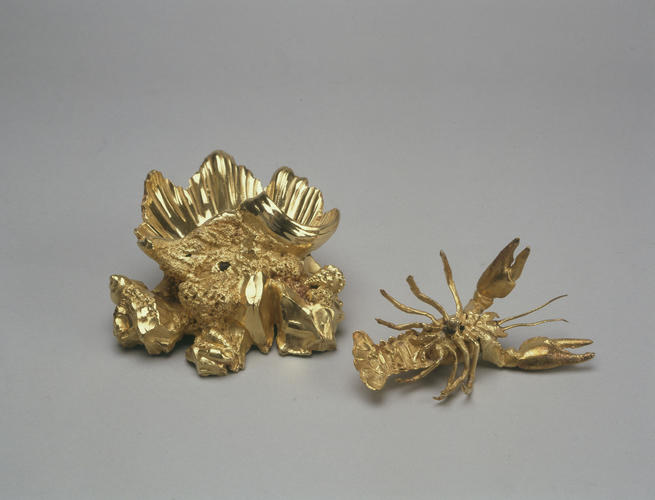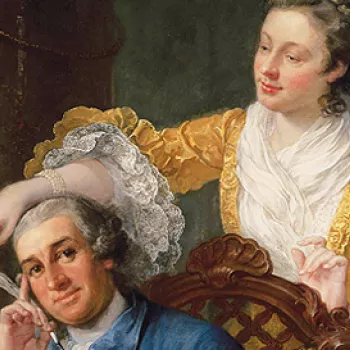Nicholas Sprimont (1716-71)
Salt hallmark 1742/3
Silver gilt | 8.5 x 17.6 x 12.0 cm (whole object) | RCIN 51393
-
A pair of silver-gilt salt cellars, each cast in the form of a crayfish crawling over a stylised clam shell, on a rocky base with shells, coral and sea-foam. These salts, and an accompanying pair mounted with crabs, form part of the Marine Service, created for Frederick, Prince of Wales in the early 1740s.
The design of these pieces owes a firm debt to Juste-Aurèle Meissonnier (1695-1750). From 1734 Meissonnier, the dessinateur du roi to Louis XV, began issuing a series of engravings of work he had executed both for the king and other private patrons, in the genre pittoresque. Many of these engravings were published by Gabriel Huquier in a volume entitled Oeuvre de Juste Aurele Meissonier, peintre, sculpteur, architect, et dessinateur de la Chambre et Cabinet du Roy. Among the designs was an image of crayfish crawling over a scallop shell, surrounded by bulrushes and other aquatic plants. The designs were printed in London for the first time in 1738. Meissonnier had trained as a chaser and it is unlikely that his engravings were ever intended as a pattern book, but rather as inspiration for decorative motifs.
Certain English aristocrats in the 1730s and 40s commissioned silver directly from French goldsmiths – the most celebrated example being Evelyn Pierrepont, 2nd Duke of Kingston (1711-73), who asked Meissonnier himself to design a set of tureens and vegetable dishes in the most exuberant rococo style, displaying an extravagant confection of vegetables and game on asymmetric bodies. Although Frederick may have purchased Meissen porcelain through the offices of Lord Baltimore, for plate he seems to have relied on English makers, albeit those most sensitive to the latest French styles. Nicholas Sprimont was one of the few goldsmiths who could translate Meissonnier’s fascination with natural shapes and extreme asymmetry into concrete form. The goldsmith was described by his widow as having “superior skill and taste in the arts of drawing and modelling and painting”.
Sprimont’s fondness for the form of these salts manifested itself again when, as director of the Chelsea Porcelain Factory in the 1750s, he had them produced in porcelain. For example see RCIN 103913.
Text adapted from The First Georgians: Art and Monarchy 1714-1760, London, 2014Provenance
Almost certainly made for Frederick, Prince of Wales
-
Creator(s)
(goldsmith)Acquirer(s)
-
Medium and techniques
Silver gilt
Measurements
8.5 x 17.6 x 12.0 cm (whole object)










